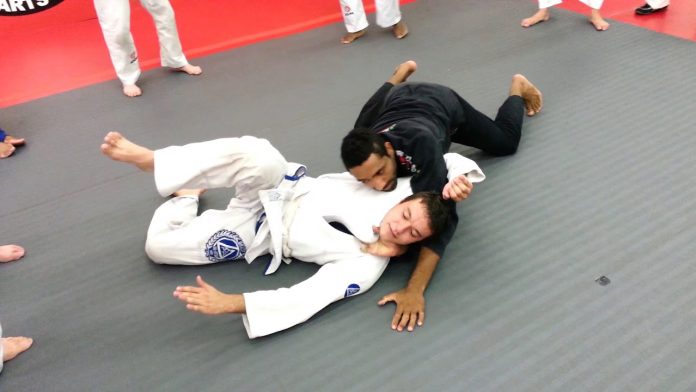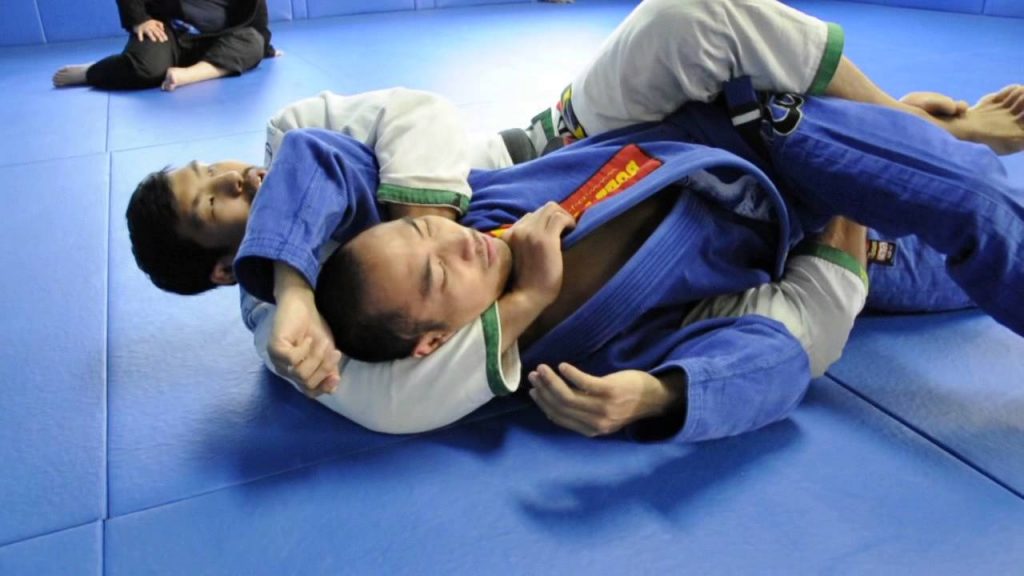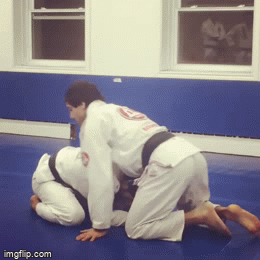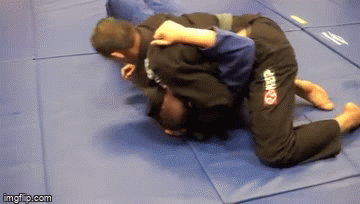
“Position before submission” is the age-old mantra that we hear over and over again. I really dislike that one. I’ll share a few examples as to why later on. The key point is, you can’t really finish someone from a position that scores points. You can only finish from the position the submission configuration leads you to. In other words, that is the position you want to be controlling, rather than looking to stay in a scoring position. That’s why sometimes, rolling BJJ GI chokes work much better than their counterparts from the back or front headlock.
Submitting people in Brazilian Jiu-Jitsu is the hardest part of the sport. It is more fun than anything else, but if you take a look at how many submissions you’ve lost compared to how many ended in taps you’ll see that you’re way behind on your taps. That is because finishing someone is hard, and it just gets harder the closer you get to a submission. BJJ GI chokes make that task a bit easier by employing the Gi as a weapon. Rolling to get them and/or make them tighter only adds fuel to the fire.
The Issue With Positional Jiu-Jitsu
Let’s tat off with my issue with the mantra about the position before submission. Mount is a position. The armbar is a submission. Being in mount is very far from finishing an armbar. In between that position and the submission, there’s the entire sport of Jiu-Jitsu to be played. It is a similar situation with the back and the Rear Naked Choke, or any other choke. And it all boils down to patience.

With chokes using Jiu-Jitsu gi, there’s a shortcut to this. Instead of battling for the submission position directly, you take a shortcut by rolling straight into one. The one prerequisite is that you set up a purposeful grip so that when you roll, you end up ready to finish with the slightest pressure, and without a chance for the opponent to defend.
More movement, More control
As controversial as it may sound, in BJJ, you want people to move. If they stay put, and you stay put, you’ll probably both get penalized at a tournament. Plus, there’s no fun in it. If it was wrestling, judo, or even Sambo, you might want to hold a person down for the pin, and points. However, in BJJ three’s no point in staying static. In fact, it offers no control, but rather just the restriction of movement.
Whenever someone moves in BJJ, and you’re the one in a position of control,, that movement opens up even more control for you. Simply look to limit their movements in a specific direction by using superior mechanics. From there on, patience will cause the person to be attacked to try and move. All of their movement is actually something that is providing you with more control. And that is exactly what you want when you’re trying to submit someone – control.
The rolling portion on rolling BJJ Gi Chokes is actually a means of control. It servers to get you in a spot where you maximum control and /or remove slack from the submission you otherwise wouldn’t be able to get easily. That, and there’s a psychological moment where the opponent is clueless to what is happening around them. That is also a type of control.
A Few Cool Rolling BJJ GI Chokes
There are plenty of BJJ Gi Chokes, and some of them are set up by rolling. The rolling part is fun, can look scary, and will take time to get used to it. However, it will take you from a position of battle to a position of superiority. Moreover, rolling makes the BJJ Gi chokes tighter, easier to control, and much better looking. There are countless ways to grip a Gi for a choke, as well as countless directions for rolling. Below we’ll just take a look at several of those chokes that are pretty fun to go for.
The Rodado Choke

The Rolling Collar Choke

The Rollover Lapel Choke

Rolling Turtle Choke

Contrary to popular belief, you need to completely pull away from the opponent, bar that collar grip. This will allow you to swing a leg over, trap the far arm with your am and roll. One of the best-looking BJJ Gi chokes ever, along with one of the most attractive setups you’ll ever learn. Not to mention how tight this one is.
Conclusion
BJJ Gi chokes work. They work even better when you set them up using rolling setups. As long as you can change the way you think about BJJ control, rolling to get submissions will not be scary. In fact, it will start o seem logical and very straightforward. Focus on the finishing position as the one you need to control, and use all means at your disposal of getting there, or making it tighter. Rolling is just one.


![Darce Choke Encyclopedia – Origins, Mechanics and Variations [2025] BJJ, choke, Brabo, BJJ Darce Choke, D'arce Choke, Darce BJJ Choke](https://bjj-world.com/wp-content/uploads/2017/11/JungPoirierLeeYahoo-218x150.jpg)









![Jiu-Jitsu For Old Guys Guard Retention Bernardo Faria DVD Review [2025] Jiu-Jitsu For Old Guys Guard Retention Bernardo Faria DVD Review](https://bjj-world.com/wp-content/uploads/2025/03/old-guys-guard-retention-bernardo-faria-dvd-review-218x150.png)
![X-Guard Trickery Kyle Sleeman DVD Review [2025] X-Guard Trickery Kyle Sleeman DVD Review](https://bjj-world.com/wp-content/uploads/2025/03/x-guard-trickery-kyle-sleeman-dvd-review-218x150.png)
![Countering with Crab Ride Anthony Budion DVD Review [2025] Countering with Crab Ride Anthony Budion DVD Review](https://bjj-world.com/wp-content/uploads/2025/03/countering-with-crab-ride-anthony-budion-dvd-review-218x150.png)
![Closet Closed Guard Craig Jones DVD Review [2025] Closet Closed Guard Craig Jones DVD Review](https://bjj-world.com/wp-content/uploads/2025/03/closet-closed-guard-craig-jones-dvd-review-218x150.png)
![Xanadu Back Takes Levi Jones-Leary DVD Review [2025] Xanadu Back Takes Levi Jones-Leary DVD Review](https://bjj-world.com/wp-content/uploads/2025/03/xanadu-back-takes-levi-jones-leary-dvd-review-218x150.png)


![Power Passing Body Locks Dan Manasoiu DVD Review [2025] Power Passing Body Locks Dan Manasoiu DVD Review](https://bjj-world.com/wp-content/uploads/2025/01/power-passing-body-locks-dan-manasoiu-dvd-review-100x70.png)
![Edging Yourself Out Of Danger Craig Jones DVD Review [2024] Edging Yourself Out Of Danger Craig Jones DVD Review](https://bjj-world.com/wp-content/uploads/2024/12/edging-yourself-out-of-danger-craig-jones-dvd-review-100x70.png)
![The Bear Trap Nicolas Renier DVD Review [2025] The Bear Trap Nicolas Renier DVD Review](https://bjj-world.com/wp-content/uploads/2025/01/the-bear-trap-nicolas-renier-dvd-review-100x70.png)
![Ginastica Natural Alvaro Romano DVD Review [2024] Ginastica Natural Alvaro Romano DVD Review](https://bjj-world.com/wp-content/uploads/2024/12/ginastica-natural-alvaro-romano-dvd-review-100x70.png)
![BJJ Foundations Mikey Musumeci DVD Bundle Review [2024] BJJ Foundations Mikey Musumeci DVD Bundle Review](https://bjj-world.com/wp-content/uploads/2024/09/bjj-foundations-mikey-musumeci-dvd-bundle-review-100x70.png)
![Jeff Glover DVD Bundle Review: Chokin’ Around With Uncle Jeff [2024] Jeff Glover DVD Bundle Review: Chokin' Around With Uncle Jeff](https://bjj-world.com/wp-content/uploads/2024/10/jeff-glover-dvd-bundle-review-chokin-around-100x70.png)



![Baseball Chokes From Everywhere Magid Hage DVD Review [2025] Baseball Chokes From Everywhere Magid Hage DVD Review](https://bjj-world.com/wp-content/uploads/2025/01/baseball-chokes-from-everywhere-magid-hage-dvd-review-100x70.png)

![Back Control and Submission Felipe Pena DVD Reveiw [2025] Back Control and Submission Felipe Pena DVD Reveiw](https://bjj-world.com/wp-content/uploads/2025/01/back-control-and-submission-felipe-pena-dvd-reveiw-100x70.png)





![Compass Kneebar System Charles Harriott DVD Review [2024] Compass Kneebar System Charles Harriott DVD Review](https://bjj-world.com/wp-content/uploads/2024/11/compass-kneebar-system-charles-harriott-dvd-review-100x70.png)







![Dynamic Headquarters Passing Jason Rau DVD Review [2024] Dynamic Headquarters Passing Jason Rau DVD Review](https://bjj-world.com/wp-content/uploads/2024/10/dynamic-headquarters-passing-jason-rau-dvd-review-100x70.png)


